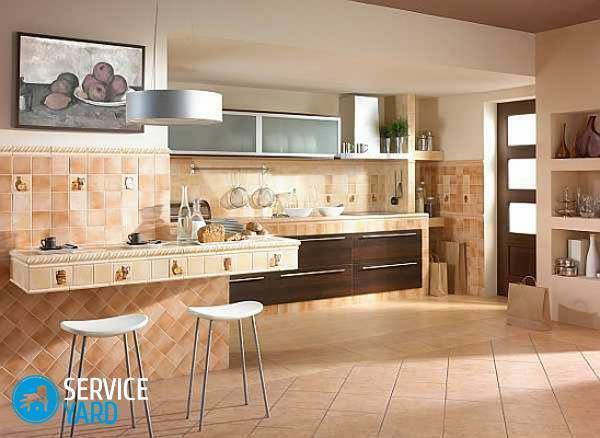
-
- Tiles for the apron
- General advice:
Despite the large selection of flooring materials in the house, the tiles remain unbeatable. And in this article, we'll talk about which tile to choose on the floor in the kitchen, so as not to be disappointed in the choice.
to content ↑The main types of
The reason for such great popularity of this type of coating is a wide variety in color, size and material of manufacture. So, to choose a tile on the floor in the kitchen, you will use such materials:
- Ceramics - made from natural materials such as clay and minerals.
- Ceramic granite - also made of natural materials, differs from the first version with higher performance characteristics
- Natural stone.
Important! There are also other types of tiles, but they are not suitable for stowage in the kitchen and will not be considered here.
Let's analyze the advantages and disadvantages of each type of coverage.
to the contents ↑Ceramics
Ceramics has long been an excellent building material and has been used in various areas of building construction. If you want to choose a tile on the floor in a kitchen of this type, you definitely will not go wrong, but you will also relatively save.
Advantages:
- Variety of style solutions and colors.
- Variable surface texture.
- Wear resistance - for both mechanical and temperature differences.
- Refractoriness - this characteristic is acquired during manufacture.
- Immunity to moisture.
- Plus its natural origin without the interference of synthetic materials.
- The variety of tile sizes allows you to choose a floor tile suitable for you.
Disadvantages of
As with any material, ceramics have their drawbacks, which are as follows:
- High thermal conductivity means that in the cold season the floor will not be very warm. It is solved by arrangement of warm floors.
- If water gets to the surface, the floor becomes very slippery, which is dangerous.
- The installation of ceramic tiles can also be considered a disadvantage, since certain skills are required to work with it.
- Ceramics are quite fragile material - they can be damaged during installation and transportation.
Ceramic granite
Ceramic granite has recently appeared on the market as a more expensive version of the usual tile. How feasible is the purchase of such material for the kitchen?
Advantages of
The advantages of this coating are undeniable. Among them:
- Longevity.
- Resistant to moisture and temperature extremes.
- High strength.
- Immune to mechanical and chemical effects.
- Simple care.
- Environmentally friendly.
- Large selection of colors and sizes.
Disadvantages of
Among the disadvantages of this solution:
- The complexity of installation.
- Quite solid surface, which means that if it falls on the dishes, it will necessarily break.
- On the porcelain stoneware are very noticeable stains and stains.
- Very difficult transportation.
- As in ceramics, high thermal conductivity and with the ingress of water becomes a slippery floor. The second moment is solved by purchasing collections with increased protection against slipping, but the price of such material is correspondingly more expensive.
Natural stone
Natural stone is considered to be the most durable and durable. Used for the manufacture of materials like marble, granite and slate.
Advantages of
The most famous advantages of this material are:
- Long service life.
- High resistance to wear.
- Strength.
- Resistant to changes in temperature and moisture.
- Ability to recover from damage.
- Care that does not require much effort.
Cons
Among the shortcomings:
- Big weight.
- Low resistance to acids - and they are in many products in small quantities.
- Color change when exposed to moisture.
Features
In order to choose the right tile for the kitchen floor correctly, you need to know what characteristics to look in the store. Let's consider them in detail.
Wear resistance
The service life of the floor covering depends on the wear resistance. This characteristic shows how strong the load will withstand this or that coating.
Classes of wear resistance divided into 5 categories and denoted by the abbreviation PEI:
- PEI I - this kind of the smallest durability and it is used only for wall finishing.
- PEI II - this type of coating is more stable than the previous one, it is used in those rooms where they will walk barefoot or in slippers.
- PEI III - this type of coating is designed for mounting any rooms except kitchens.
- PEI IV - a high degree of strength of such material is used for finishing premises with a high degree of attendance.
- PEI V - material with this marking has the highest degree of wear resistance. Used for finishing shops and premises with the highest attendance, or where large mechanical loads.
Important! From all of the above, we conclude that the tiles marked PEI IV and PEI V are suitable for the kitchen floor.
. Moisture resistance
This characteristic is measured in percentages and is divided into 3 classes:
- class 1( 0,05%) - this characteristic is inherent in porcelain tiles and is capable ofto withstand heavy loads in terms of moisture.
- Class 2( up to 6%) - this class is designed for floor installation, so it is with this class of moisture resistance that you should choose a floor tile for the kitchen.
- class 3( up to 10%) - this type is intended only for wall mounting, where the effect of moisture is the least.

Resistance to chemical damageThis characteristic is also marked. It is denoted by the letters AA, A, B, C, D. The tile with the letters AA and A is the most resistant to damage by chemical substances. Therefore, to stop your choice is precisely on this marking, because you will mount it in a room where aggressive substances are often used.
Material safety
Safety of tiles is also an important factor. The most important factor in safety is the friction coefficient of the tile, as it is known that this material itself is a rather slippery element and represents a danger.
Tiles are divided according to this criterion into 4 categories:
- Maximum safe - the coefficient is more than 0,75.This tile is suitable for the most humid rooms.
- Relatively safe - 0,39-0,74.Tiles of this type can also be placed in the kitchen and in other rooms.
- Dangerous - has a coefficient value of 0.19 to 0.39.
- Very dangerous - the value of the coefficient is from 0 to 0.19.
Important! Before choosing a tile on the floor in the kitchen, it is very important to pay attention to its technical characteristics. This will not only help you keep the longevity of the coating, but also protect your life.
Variety of tile cover
This type of flooring is glazed and matt. Due to the characteristics of production, the second type is much inferior as the first, as it is processed at high temperatures.
Glaze does not allow moisture to penetrate inside, making it more durable.
Important! The roughness inherent in some types of tiles is not always desirable. This is due to the fact that there is a large amount of dirt inside, which is very difficult to clean and wash.
Sorts
Like some other materials, tiles are divided into several varieties:
- The first grade has less than 5% of the marriage.
- The second grade has less than 20% of the reject.
- The third grade is the most inexpensive and low-quality coating.
Important! Each of the varieties is marked with its own color. The first grade - red, the second - blue, the third - green.
to the contents ↑Design and dimensions
The design of tiles is not the least important. In order to choose a tile on the floor in the kitchen, you need to focus on the overall design decision of the room. The visual space of the room also depends on the color of the material:
For light kitchens, light colors are suitable - they visually expand the space, make the room lighter.
For spacious you can choose contrasting collections with bright, saturated colors.
A big role is played by the size of the tiles:
- Small or visually reduces the space.
- For original decorative solutions, use a polygonal coating.
- And in order to make the kitchen luxurious, you will perfectly fit stone tiles.
- On the size and ease of laying. The more, the easier.
Important! You can make the styling more original by arranging it in an unusual way or by combining several types.
to the table of contents ↑Tile for the apron
The working wall is also mainly made with tiles and is called the kitchen apron. To understand which tile to choose for the kitchen on the apron, the following recommendations will help you:
- Wear resistance of such material should be PEI I and PEI II.
- Moisture resistance is the same as for floor tiles.
- Resistance to chemical attack - AA or A.
- The most optimal size for an apron is 15x15 cm.
Important! Count the number of tiles you need not only considering the dimensions of the material itself, but also the size of the seams between them.
- You can choose a glossy, matte and embossed surface.
Important! The glossy surface looks more impressive, but any drop of contamination is noticeable on it, it needs to be often wiped.
to the contents ↑General advice:
- Often as a solution to the kitchen manufacturers make a tile of the same style for the floor and apron. This is great for those who redesign the design completely.
- When buying, take 10% more coverage than calculated. When transporting, laying some materials can be damaged and they will have to be replaced.
- When buying tiles of different designs, make sure that it corresponds to the declared size, because a difference of even 1 millimeter can significantly affect the size of the seams and not look good.
When choosing a tile for a kitchen, remember that the guarantee of a good purchase often depends on the care of the buyer for the technical details. Take your time, look on the Internet, ask your friends - you will definitely choose the product that is right for you.



